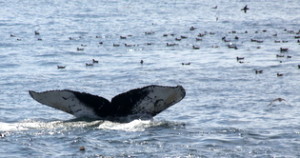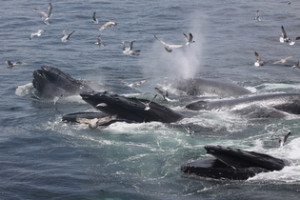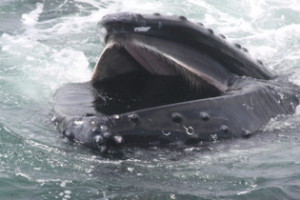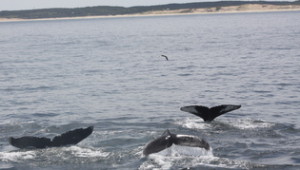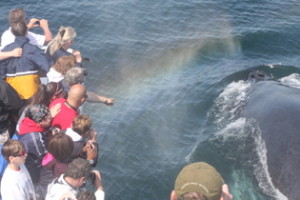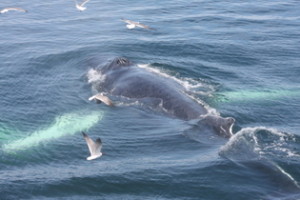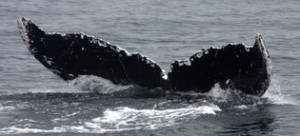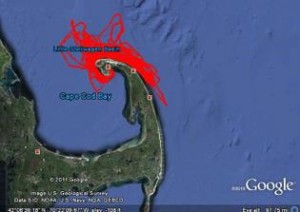June 18 to June 24
First, some big news: Salt is back! Salt, a humpback whale that we’ve been watching since 1975, was seen East of Cape Cod on June 20th by the Provincetown Center for Coastal Studies. Salt was the first whale to get an official name based on the “salty” appearance of her white dorsal fin, and she has been since almost every year since then. On behalf of the Dolphin Fleet, welcome back!
On June 18th on both trips there were Minke whales absolutely everywhere we looked! These small whales appear and disappear rapidly, but today it was easy to get a good look as they popped up in every directions. Because of their elusive behavior, they are chronically under-studied, and not as much is known about them, especially compared to the more surface-active humpback. The Ocean Research and Education Society just launched a new website which explores Minke whale research in the St. Lawrence estuary. Check it out to learn more about these incredible animals.
The humpback whale feeding frenzy of last week persisted and we had over 15 humpbacks blowing perfect bubble nets and lunging through schools of sand lance with their mouths wide open. Among the humpbacks sighted today were Abrasion, Flounder, Etch-a-Sketch, Springboard, Barb, Harrow, Polaris and Dome.
Dome
These whales were feeding just off of High Head in Truro, which also happens to be a major haul out spot for seals. These seals will often haul out on the beach at low tide and move offshore when the tide moves in. As we were heading in from the morning trip, we had a group of 10 to 15 gray seals, including one pup, heading offshore to feed as the tide turned.
On June 19th, we headed back towards the Highlands of Truro, marked by the radar dome atop the bluff. For the past few days, we’ve had a consistent group of humpbacks feeding in this area. It takes a little over an hour to get to this spot, but it was worth it. We found one humpback at first, but the group quickly grew to 2, then 4, then 6, as whales joined and began to feed in the middle of one giant net of bubbles!
We weren’t surprised to find that the group consisted of Cajun, Abrasion, Rattan, Polaris, Barb and Joy. These whales have been feeding in the same big group for the past few days!
We noticed an interesting behavior change as the tide slacked. The feeding subsided and two whales from the group became quite active, rolling on their sides and slapping their flippers. One of them tail breached once while still moving along with the bunch.
In the midst of all of this, the Minke whales and gray seals seen in droves the previous day could still be seen popping up everywhere!
June 20th was characterized by spectacular weather. Calm seas and bright sun made the longer than average search for whales a pleasure. We traveled towards the Truro Highlands where whales were seen in the previous day, but there were no birds or whales in sight! As we cruised further south, we finally had our first sighting of a Minke whale, and while we were watching it, a much larger fin whale surfaced, giving our passengers a great look at the second largest whale in the world!
As we were waiting for this whale to resurface, our first mate, Lacey, spotted whales several miles away. We traveled all the way down to Wellfleet where our group of humpbacks had traveled during the night. Cajun, Centipede, Polaris, Abrasion, and Rocker blew double bubble rings as a big ball of gulls swooped down overhead.
On the Dolphin IX, these bubble rings boiled up right next to the boat, and the whales came up so close that passengers could see right into the whales’ extended mouth!
On the sunset trip, we found the same group of whales still continuing to cruise southward. After one whale had a close encounter with a lobster pot, it started to breach, seemingly agitated with its near entanglement! For the duration of the trip, we watched whales off the beaches of Wellfleet, as Minke whales popped up all around us.
June 21 was a beautiful, flat calm day. We spent the day following a humpback named Harrow who was first seen in 2007. Harrow was named for the distinctive lines on her flukes which are reminiscent of the method of cultivating soil in rows. We couldn’t help noticing that this whale was on the move! She zig-zagged between Race Point and the Southwest corner of Stellwagen Bank, and we had to stay sharp watching for her between surfacings!
We also had a few wonderful looks at Minke whales off of Highland Light. These whales can be difficult to spot, but when there are a few of them around, the calm seas are often punctuated with their sharp rostrums breaking the surface.
June 22 was gray and overcast but the seas were calm and a beautiful pewter color. We had great looks at two fin whales very close to shore on our morning trip. It was hard to believe that less than a mile from Race Point these two enormous whales were swimming in over 150 feet of water. After consulting our ever-growing fin whale catalog on board, we were unable to match them as individuals based on their dorsal fin. They both turned out to be new sightings for the year!
On both morning trips, we caught up with two humpbacks, Polaris and Bisou, near the southern edge of Stellwagen Bank. Polaris is a male first seen in 1984.
Polaris
Bisou, which means “kiss” in French was named for a small marking on its fluke that looks like a lipstick stain. Bisou was first seen in 2002.
Bisou
Bisou and Polaris traveled side by side for the better half of the day. For the most part, their behavior could be categorized as slow, linear travel, except for one instance in the afternoon. After a long dive, Polaris burst to the surface, and quickly dove again. “Watch out at 1 o’clock!” the captain exclaimed! Sure enough, Polaris emerged in a full spinning breach! Often it can be hard to predict when a humpback is going to breach, but we all agreed that Polaris had displayed the most obvious “wind-up” we had ever seen!
By the last trip, Bisou and Polaris had disappeared, but we had a small humpback who was swimming parallel to the boat. We clocked its speed at about 6 knots, and although it didn’t spend too much time at the surface, we could trace its movements by watching the greenish glow reflecting from its white flippers progress forward.
Fog, rain and heavy seas made trips on June 23 very challenging. The afternoon trip aboard the Dolphin VIII was finally able to locate a pair of humpbacks traveling steadily to the east. We were excited to see that they were two old Stellwagen favorites, Anchor and Nile. Both of these humpbacks have very distinct markings on their tails making them easy to identify. Nile, a female born in 1987 has a Nile river shaped marking on her left fluke, while Anchor’s eponymous pigmentation pattern is located toward the bottom of the left fluke.
Nile
Anchor
The miserable weather persisted into June 24, but we did manage to get a great look at a small Minke doing some sub-surface feeding right off of Race Point Light. This little whale popped up periodically, but while we were waiting for it to surface, we could feast our eyes on the 150 gray seals that were making their way offshore. These large seals spend much of their year off of the Cape feasting on fish and crustaceans. They can be distinguished by their horse-like profile.
We headed north toward the Stellwagen Bank National Marine Sanctuary, and after much searching in the fog, we were able to get a good look at a fin whale which popped up right next to us. After a difficult day on the water, it was exciting to spend some time with the second largest animal on the planet!
Next week, we’re hoping for sunny skies and calm seas! Here’s where we went this week:






